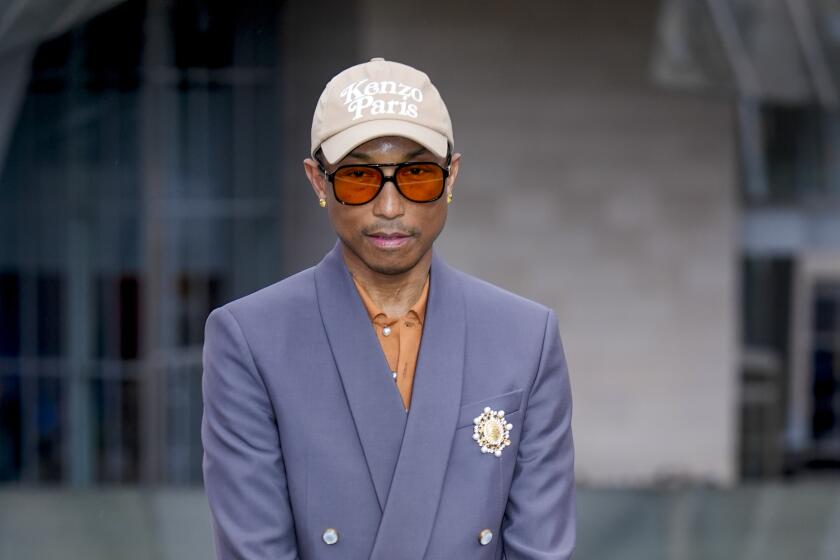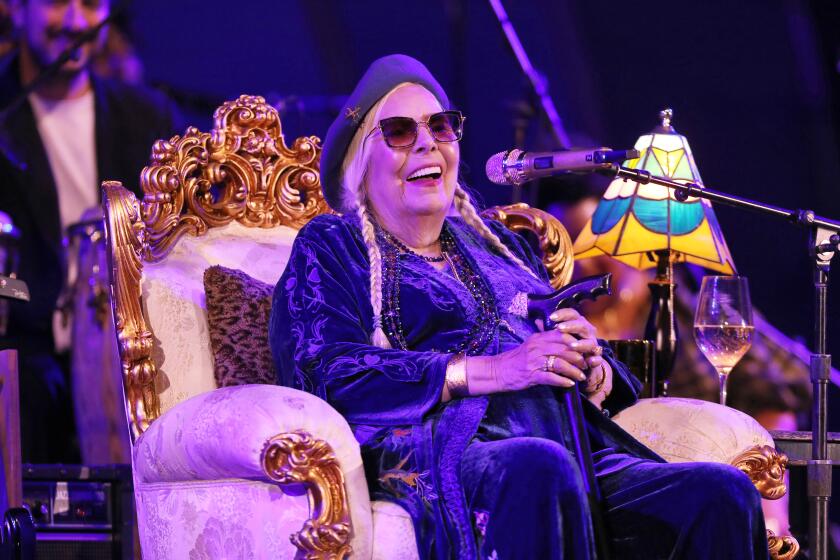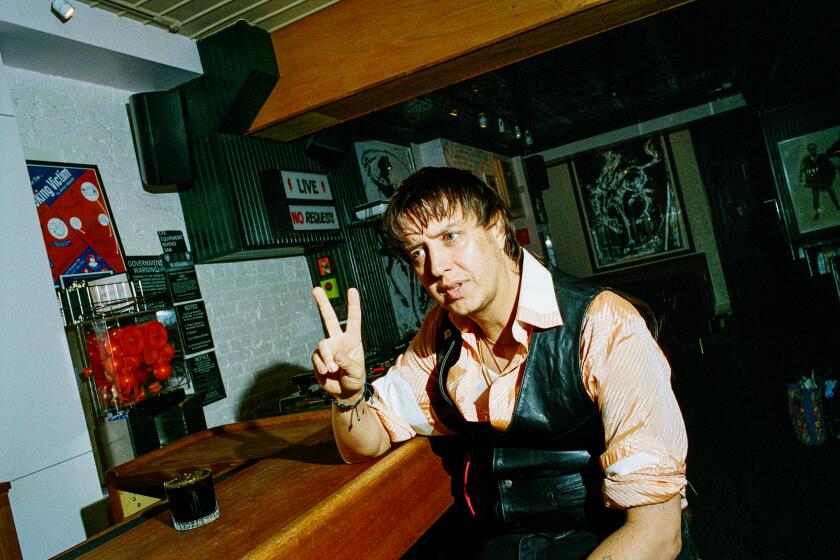It’s Trad, Dude
FULLERTON — On a recent hot Sunday at the Elks Club here, saxophonist Bruce Gifford’s Jazz Generation band played an enthusiastic, if not artful, version of “Down Bourbon Street” as women with parasols sashayed around the dance floor to the encouragement of some 100 members of the New Orleans Jazz Club of Southern California.
It’s a scene repeated monthly in Fullerton and elsewhere across the country when music club members gather for jam sessions and a band performance. Many in the crowd, made up of mostly retirees, remained in their chairs during the music, nodding and smiling to songs they’ve enjoyed for decades. Others were on their feet, cutting a rug with steps first made popular 60 and 70 years ago.
“We used to go hear bands at places like the Hangover Club, the Beverly Cavern, the Casino Gardens in Venice and Billy Berg’s in Hollywood,” said the club’s publicity director, Jesse Noriega, moments before wife Liz dragged him off to dance. “We’d hear guys like Slim Gaillard, Harry ‘The Hipster’ Gibson, Louis Jordan. You can’t find music in the clubs like that anymore.”
Though the current swing revival has drawn young adults to faux-’40s supper clubs for music bands and dancing, early forms of traditional, or “trad,” jazz have been largely ignored by boomers and post-boomers. That truth is the trad lovers’ biggest fear: The music of their younger days will disappear with them.
The trad-jazz scene includes a wide slice of early jazz and popular music, ranging from true New Orleans roots music and early Chicago sounds to sophisticated Dixieland and Roaring ‘20s pop standards. Among its fans are a few too young to have heard the music in its heyday.
Noriega, who puts his age at “70 plus,” started following the music in the late ‘30s. “What caught me was when I first heard [cornetist-bandleader] Mugsy Spanier and the Ragtimers. Then I was attracted by [singer-bandleader] Bob Crosby and his Dixieland band.”
Fans’ devotion to what they invariably describe as “happy music” runs deep.
“The thing that separates [trad] from more modern jazz is melody,” explained 69-year-old club historian Janet Kane. “There’s always a toe-tapping melody line, and you just can’t keep your feet quiet.”
Adds Noriega: “No matter where you are or how you feel, it always puts a smile on your face.”
Today’s audience for the happy sounds of trad jazz appears fairly healthy, though hardly the stuff of commercial pop. More than 100 trad and Dixieland clubs such as the New Orleans Jazz Club of Southern California dot the country, with a cluster on the West Coast. A dozen area trad-jazz clubs operate under the United Jazz Clubs of Southern California umbrella. All hold monthly musical meetings, usually on Sunday afternoons, at Elks lodges, hotels and other gathering halls.
True devotees travel widely to attend any number of special classic jazz events. The largest trad festival, held each May in Sacramento, includes 100 bands with a total audience of 100,000 over four days. The New Orleans Jazz Club’s annual SoCal Jazz Fest, held this year on a September weekend at the Buena Park Holiday Inn, hosted 15 bands and about 1,000 people on each of three nights.
Despite such strong overall attendance, only a handful of the recent SoCal fest’s attendees qualified as baby boomers or younger, though many of the musicians did. And attendance was down from years past.
*
In its 1968 charter, the nonprofit New Orleans Jazz Club of Southern California dedicated itself to “the promotion and preservation of traditional/Dixieland jazz.” Now the club has taken serious steps to ensure the music’s preservation. Following in the lead of other trad-jazz organizations, it established a scholarship program this year for promising young Orange County musicians.
But unlike other clubs, the 400-member New Orleans group, in details to be worked out, will require the money go toward trad-specific education, such as a stint at Sacramento Traditional Jazz Society’s annual jazz camp, where 100 students ages 12 to 17 spend a week in August studying early jazz.
The New Orleans jazz club has long contributed to the United Jazz Clubs of Southern California’s Youth Scholarship Awards, which at the recent SoCal fest handed out $500 scholarships to three teens selected from a group of 35. The winners--a guitarist, a saxophonist and a trombonist--appeared on the festival stage with Chris Kelly’s Black and White Jazz Band.
Also appearing was the James P. Johnson Foundation Youth Ensemble, out of Riverside, directed by the grandson of the legendary Harlem stride pianist. After the ensemble’s performance of Duke Ellington, a decidedly nontraditional tune from Thelonious Monk and “The Charleston,” 17-year-old saxophonist Adam Smith said that while he likes Dixieland and related music, they’re not his first love.
*
Roger Krum, executive director of the 4,600-member Sacramento club, the nation’s largest, doesn’t see that as a problem.
“We know that some of the young musicians who attend our jazz camp may not continue to play [traditional jazz]. Most are going to move into other, more current styles of music. But if we plant the seed at that early age, eventually they’re going to come back to it and incorporate early jazz styles in their music.”
Scholarship programs might train a new generation of musicians in trad, but they can’t guarantee an audience. So the Sacramento club travels to local schools. “We show students where jazz music came from and just how prevalent that music is in our society today.”
The New Orleans club is considering a similar program of concerts, presentations and discussions. Meanwhile, all of the clubs face the difficult task of involving young people in their activities. The key, some believe, may lie in the current rage of swing dancing.
“I don’t know why the kids who like swing don’t get into this music,” said an under-40 wannabe flapper at the SoCal fest. “All it will take is someone who’ll say, ‘Hey, this music is as hip as swing and just as fun to dance to.’ Then it will catch on.”
Tim Wilhite, a 44-year-old trad jazz enthusiast who won the SoCal fest’s Charleston contest, said swing music and dancing isn’t half as much fun the older music from the ‘20s and early ‘30s. “It’s positive, has a great beat, and you can dance to it,” he explained in American Bandstand terms. “People seem to go along with trends, and swing music is the trend right now. But I think it would be fantastic to see a club playing authentic music of the ‘20s with everyone in vintage dress and nothing to remind you of the present.”
Noriega views the challenge of luring younger dance and music fans in more practical terms, a matter of getting fliers and posters to the places where swing dancers congregate.
“Some dancers follow the better bands, like [Chet Jaeger’s] Night Blooming Jazz Men, and will show up at meetings when they play. We have to figure out how to get them here all the time.”
Krum, who reports that a significant number of people in their 20s attended the most recent Sacramento fest, doesn’t see the loss of traditional jazz any time soon.
“It’s been around for several decades and will be around for several decades more. Even during the ‘20s, the era called the Jazz Age, jazz was not the majority music, but just part of a larger tapestry. And it’s always going to be part of that tapestry.”
* For information on the activities of the New Orleans Jazz Club of Southern California, call (714) 664-1408.
More to Read
The biggest entertainment stories
Get our big stories about Hollywood, film, television, music, arts, culture and more right in your inbox as soon as they publish.
You may occasionally receive promotional content from the Los Angeles Times.










